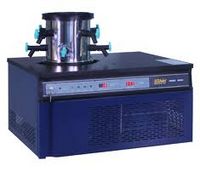Lyophilizers
The Lyophilizers are used especially for Lyophilization process. It is a complex process of removing water from the product through sublimation at low temperature & vacuum. The equipment (often called Lyophilizers) is a very difficult type of chamber to thermally map. A lyophilizer has many shelves that are closely spaced together to hold product. Accurately measuring the shelf temperature during the process cycle can be quite challenging particularly if using thermocouples.
Installation of thermocouples into a lyophilizer is very time intensive. Thermocouples must be threaded into the chamber through the vacuum line using a special flange assembly. The tip of each thermocouple must be carefully strapped or taped onto multiple positions of each shelf. If not done properly, the shelf temperature measurements will not be accurately mapped. Vacuum leaks and broken thermocouples are common problems which can add significantly to equipment downtime.
Using a thermocouple based system for this application should be considered only if seeing live data is absolutely necessary. For Lyophilizers it is new and has never been qualified. In this case, seeing live data may be advantageous to allow for mechanical adjustments or to determine product load configurations.
The better alternative is to use wireless dataloggers that are designed to handle this application. The Lives data of wireless dataloggers are ideally suited for mapping lyophilizers. Each datalogger has an 18 inch extended sensor. A copper cap is provided that slips onto the bottom portion of each datalogger. The copper cap has a groove so that the sensor can be flush mounted. The datalogger can then be placed on any shelf location with the thermally insulated to the shelf temperature.
In summary, the live data of wireless dataloggers can save substantial hours of labor and equipment downtime for this application. Also, periodic verifications of the process conditions can be easily done without disruption to operations.
